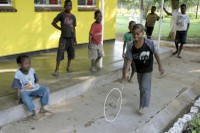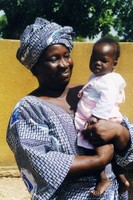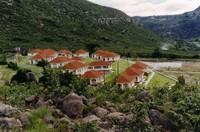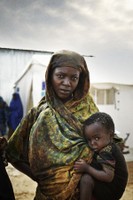What happened next?
1986 (1 year after Live Aid)
Uganda: Rebels seize power and install Yoweri Museveni as president.
Cameroon: Close to 2,000 people die, many in their sleep, as poisonous gases from Lake Nyos kill all life in the surrounding 15km.
1987 (2 years after Live Aid)
Mozambique: SOS Children starts building a village in Tete, Mozambique to provide family based care for children left orphaned by the civil war. During construction an emergency relief program is run to deal with the effects of famine.
1988 (3 years after Live Aid)
Somalia: SOS Children opens a hospital in Somalia treating 30,000 patients a year.
Burundi: Tutsis massacre thousands of Hutu
1989 (4 years after Live Aid)
DRC: SOS Children sets up a Children's Village in Bukavu DRC (formerly Zaire) where the worst of the conflict has left many children without parents.
Uganda: SOS Children sets up a Children's Village to provide family-based care in Kakiri Kampale.
South Africa:FW de Klerk replaces PW Botha as president. He agrees to meet Nelson Mandela and frees many ANC activists.
Mozambique: Emergency Relief Programme is set up to aid sufferers of famine.1990 (5 years after Live Aid)
Somalia: SOS Children launches a major emergency relief operation in Somalia following the outbreak of civil war.
Rwanda: An armed group of Tutsi refugees invades Northern Rwanda from Uganda starting the Rwanda Civil War.
South Africa: Nelson Mandela is released from prison after 27 years of incarceration.
Namibia: Namibia gains its independence from South Africa on 21st March.
Algeria: After an agreement is made with the Algerian government, SOS Children relocates the village constructed in the aftermath of the 1980 earthquake, to Draria, 8 miles south of Algiers.
Ghana: SOS Children opens an International School in Tema. Offering International GCSE's and the International Baccalaureate, it educates students from all over Africa
1991 (6 years after Live Aid)
Western Sahara:Western Sahara eventually gains independence ending 18 years of armed conflict.
South Africa: Multi-party talks begin. International sanctions are lifted. FW de Klerk abolishes many apartheid laws. There is major fighting between the ANC and the Zulu Inkatha movement.
1992 (7 years after Live Aid)
South Africa: An SOS Emergency Relief Programme is established in Natal Province to provide a home for orphaned babies abandoned in local hospitals.
Mozambique: Another SOS Emergency Relief Programme is set up as the harvest in Mozambique fails. SOS Children commits to repeating this annually, with aid going to children and others suffering from malnutrition.
1993 (8 years after Live Aid)
Rwanda: A cease fire in the Rwandan Civil war gives temporary relief to long suffering Rwandans.
South Africa: FW de Klerk and Nelson Mandela jointly awarded the Nobel Peace Prize.
Burundi: Civil War breaks out in Burundi, as Hutu President Ndadaye is assassinated by Tutsi rebels. Some 300,000 die in the ensuing conflict. SOS Children sets up an Emergency Relief Programme in Muyinga, providing a home for children orphaned by the conflict.
Togo: In an attempt to push through democratic reforms, France, Germany and the USA withhold aid from Togo.
1994 (9 years after Live Aid)
Angola: SOS Children sets up a community in Lubango, Angola, to provide family based care to children orphaned by decades of conflict. A vaccination programme is started against meningitis, from which hundreds of people are dying.
Rwanda:The Rwandan genocide; in six months following the murder of President Habyarimana some 800,000 people are massacred. SOS Children immediately sets up an Emergency Village for children orphaned by the genocide.
South Africa: Nelson Mandela is sworn in as president on 10 May, after ANC win 62.65% of the vote in the national election. SOS Children builds Cape Town village in 1994. It is the first racially integrated SOS community in South Africa following the end of apartheid.
Egypt: Severe flooding in Southern Egypt leaves hundreds dead and over 15,000 homeless. SOS Children sets up an Emergency Relief Programme in Asyut, consisting of 42 temporary family houses, medical centres and social centres.
Lesotho: After fighting and political unrest resulted in delays, the first SOS Children's Village in Lesotho opens in Maseru.
1995 (10 years after Live Aid)
Botswana: Many thousands of Kalahari tribesman are relocated outside of the Central Kalahari Game Reserve, the traditional homeland of the Kalahari.
1996 (11 years after Live Aid)
Guinea: Members of Guinea's armed forces mutiny, 30 die and the presidential palace is set ablaze.
1996-97 (11 years after Live Aid)
DRC:First Congo war starts when rebels from Uganda and Rwanda invaded DRC (Zaire). It ends with the overthrow of President Seko and the installation of rebel leader Kabila as president.Uganda: President Museveni is confirmed by election in Uganda's first direct presidential election.
Burkina Faso: A meningitis epidemic sweeps through Burkina Faso, killing 4,000.
1997 (12 years after Live Aid)
Burkina Faso: After the political situation settles, SOS Children opens its first community in Burkina Faso Ouagadougo.
Burundi: The temporary accommodation provided by SOS Children as part of the Emergency Relief Project is turned into the permanent Muyinga SOS Children's Village
1998 (13 years after Live Aid)
Angola: SOS Children sets up its first Angolan Children's Village in the capital, Lubango.
Cameroon:Transparency International names Cameroon as the most corrupt country in the world. Democratic Republic of Congo: Following unrest in the South Kivu region, SOS Children sets up an Emergency Relief Programme in Uvira. Later, this is turned into permanent SOS Children's Village Uvira.Guinea-Bissau: Fighting in the vicinity of SOS Children's Village Bissau leads to the forced evacuation of children, to Bakoteh in the Gambia, for a year.
Kenya: 224 are killed and thousands injured in a bomb explosion at the US embassy in Nairobi.
2000 (15 years after Live Aid)
Botswana: Flooding hits Botswana, leaving more than 60,000 homeless.
Ethiopia: A catastrophic drought results in SOS Children setting up an Emergency Relief Programme in Gode. This later becomes a permanent Children's Village.
Madagascar:Two cyclones hit Madagascar, leaving thousands homeless.
Swaziland: SOS Children sets up an Emergency Relief Programme in Mbabane to offer relief from the effects of the flooding in the area
2001 (16 years after Live Aid)
Ghana: Debt relief for Ghana is provided by a scheme from the World bank and IMF.
Guinea-Bissau:World Bank and IMF question the disappearance of millions from development fund.
Nigeria: Warfare between tribes leads to the Nigerian army being mobilised. Troops go on to kill over 200 civilians.
2002 (17 years after Live Aid)
Democratic Republic of Congo: An Emergency Relief Programme is set up by SOS Children following the eruption of a volcano called Mount Nyiragongo, which left thousands homeless.
Guinea, Sierra Leone, Liberia: Countries a agree deal to secure mutual borders, in order to aid attempts to counter insurgency.
Malawi: In response to the AIDS/HIV situation in Malawi, SOS Children sets up a community outreach programme in Lilongwe.
2003 (18 years after Live Aid)
Cape Verde: As a response to increasing social deprivation in the capital Praia, SOS Children opens its second village in Cape Verde in neighbouring Sao Domingos.
Kenya: Following a 3 year hiatus, The International Monetary Fund begins to provide aid to Kenya again.
Liberia: SOS Children sets up a short term Emergency Relief Programme to provide refuge for 7,000 people after fighting in Liberia.
2004 (19 years after Live Aid)
Botswana: Botswana no longer has the worlds' highest HIV incidence rate. The rate drops below 37.5%.
Liberia: Over $500 million is pledged by donors to provide reconstruction aid.
Mali: As the World Food Programme declares severe food shortages and famine, caused by locusts and drought, SOS Children's Village Mopti distributes foodstuffs and relief aid to the neighbouring area.
Morocco: Northern Morocco is hit by an earthquake, more than 500 are left dead.
Sudan: The Sudan National Army is sent to suppress the rebel uprising. There is a mass movement of refugees from Sudan to Chad, as a result of the increasing violence.
Swaziland: Swaziland is deemed to have the worlds highest incidence of HIV by the UN.
2005 (20 years after Live Aid)
South Africa: On the 2nd July, the Live 8 concert is held simultaneously throughout the G8 states and South Africa. On the 7th July, global leaders decide to increase aid to poor nations from $25 billion, by 2010, to $50 billion. Half of the money pledged would go to Africa.
Angola: Hundreds are killed by the lethal Marburg virus. SOS Children opens its second village in Benguela, a coastal area that harbored refugees throughout the Angolan civil war.
Chad: SOS Children provides Emergency Relief for victims of the Darfur crisis in the Oure Cassoni Refugee Camp in Chad.
Lesotho: Ambitious plans are announced to provide HIV tests to the whole population
2006 (21 years after Live Aid)
Benin: Benin is granted debt relief by the World Bank and the African Development Bank, as a result of the pledge made by the G8 in 2005. SOS Children opens its third Children's Village in Dassa-Zoumé.
Namibia: A polio outbreak leads to a national vaccination campaign. At least 12 die.
Tanzania: Huge debt of just under $650 million is cancelled by the African Development Bank, as Tanzania is seen to have a decent level of accountability and a good finance record.
2007 (22 years after Live Aid)
Ethiopia: An outbreak of the Ebola virus hits Ethiopia.
Tanzania: A scheme to give out subsidised anti-malaria drugs is piloted in Tanzania by ex-US President Bill Clinton.
2008 (23 years after Live Aid)
Kenya: Following post election violence, SOS Children starts an Emergency Relief Programme.
2009 (24 years after Live Aid)
Guinea:157 die and over a 1,000 injured after soldiers open fire at a stadium rally in Conakry.
Guinea-Bissau: President Joao Bernardo Viera is assassinated by renegade soldiers in a perceived revenge attack.
Kenya: The military is used to distribute food, after the Kenyan government claims that at least 10 million are in need of food.
Lesotho: A Children's Village is built in Quthing, to provide homes for children orphaned by HIV/AIDS.
Mozambique: over 350,000 people are in need of aid, as a result of famine, according to the UN.
2010 (25 years after Live Aid)
Niger: With a food crisis imminent, SOS Children sets up an Emergency Relief Programme in Tahoua, aiming to provide aid to 10,000 vulnerable children and families.
Nigeria: Fighting between Christians and Muslims in the city of Jos leaves many dead. Construction of a new SOS Children's Village in the city is delayed.
Angola: Days before the start of the African Cup of Nations 2010, an attack on the Togo team bus leaves two officials dead and several wounded
Niger: SOS Children launch an Emergency Relief Programme in Niger to help children and communities survive the effects of the developing food crisis.
South Africa: The 19th FIFA World Cup kicks off in June 2010 in South Africa, the first African nation to host the finals. Dutch and English football stars visit SOS Orphans in Mamelodi and Rustenburg.
Uganda: Several explosions in Kampala leave scores dead while they watch the World cup finals.
2011 (26 years after Live Aid)
East Africa: Famine spreads across East Africa. SOS Children launches an Emergency East Africa Famine Appeal to help as many children and families in East Africa as possible.
2012/2013 (27 years after Live Aid)
Sahel Region: SOS Children launches Sahel Emergency Appeal to help those suffering severe famine and drought.

 Return to Schools Wikipedia Home page…
Return to Schools Wikipedia Home page…
